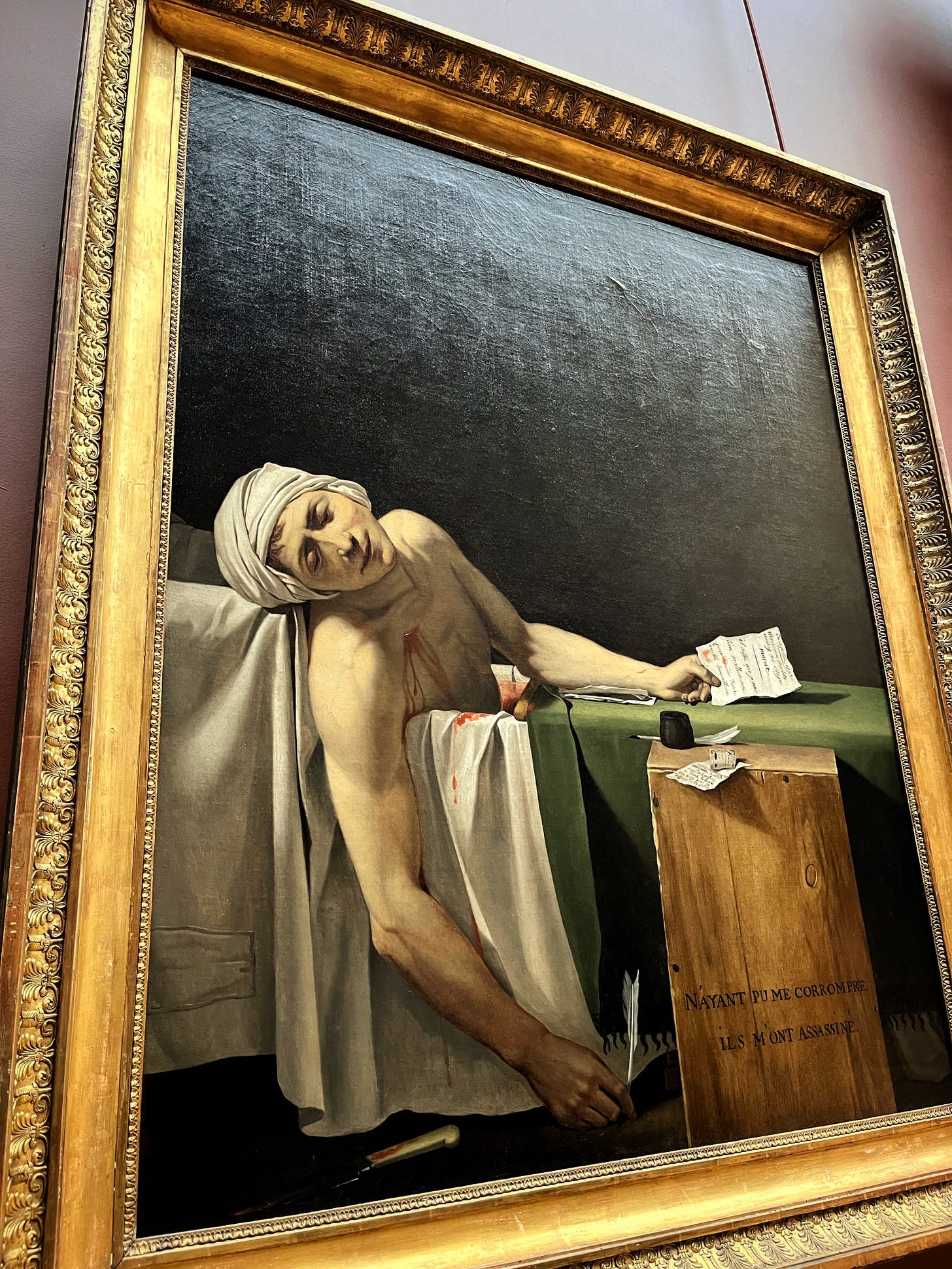*Spoiler pf the “Idiot” by Dostoyevski*
Today I am going back to art history and discussing some of my favorite paintings I’ve seen on trips.
This is “The Death of Marat” created in 1793 by Jacques-Louis David. It currently resides in Louvre where this photo was taken.
The painting shows the revolutionary leader Jean-Paul Marat shortly after his assassination by Charlotte Corday. Marat suffered from a skin condition and often worked from a medicinal bath, where Corday stabbed him. David captures Marat in a hauntingly calm and dignified death, slumped in his tub, holding a letter from Corday.
The reason that this painting haunts me still is this peaceful, dream-like portrayal of death. The light cast on the now dead body of Marat clearly stating that he is the vocal point of the painting, the calm facial expression and maybe a slight suggestion of the smile upon the deceased’s face and over all saint like representation of him is what sticks with me. Add to this seen the poetic tone of him still holding a letter and a pen in his hands, while slight blood drips down from the open wound on his chest and you have a hauntingly, disturbingly beautiful scene.
I’ve been saying this for a while, yet I’ll say it again. Everything in this weird experience we call life can be beautiful if a wise hand yields a brush or a pen…
The very simplicity of the composition and overall painting is what creates such a strong impact upon an innocent eye of the observer. The clean lines, sparse background, and soft light focus all attention on Marat, emphasizing his sacrifice and supposed purity.
The painting consists of skillful Neoclassical techniques I glazed over already. The first, and personal favorite is Chiaroscuro (light and shadow). David uses dramatic contrast between light and dark to emphasize Marat’s body and face. The light falls softly on Marat, making him appear serene, almost saintly, while the dark background isolates him and heightens the emotional intensity. Moving over to the simplicity I talked about or the better stated simplified composition. The composition is stripped of unnecessary detail. There’s a plain, unadorned wall in the background, a wooden box as a desk, and very few objects around Marat. This minimalism focuses the viewer's attention entirely on the figure of Marat, reinforcing his symbolic role. Another technique adds to the brilliance of the painting and that is something called a Pyramid Composition. Marat’s form creates a triangular shape, a classic compositional device that brings balance and harmony. This echoes Renaissance depictions of religious martyrs, reinforcing the spiritual tone.
David based Marat’s features on real-life observations, but he also idealized them. His face is peaceful and unblemished, despite the reality of a violent death. The wound is present, but it’s not graphic—it’s sanitized, elevating Marat as a martyr rather than a victim of brutality. A limited and muted color scheme is used —earthy browns, pale skin tones, and whites. This restraint enhances the solemn mood and reflects the Neoclassical preference for clarity and moral seriousness. Objects like the letter in Marat’s hand, the inkwell, and the wooden box inscribed with his name are symbolic props, connecting him to his work as a writer and revolutionary. They also anchor the scene in a narrative without cluttering it.
I could go into a lot more detail, but I’ll end on this note. The reason this painting came to my mind on this particular day is probably connected with the “Idiot” by Dostoyevski. I finished the book a few days ago and the murder of Nastasya Filipovna is what I’ll discuss now. The ghostly scene of the discovery of her death in the novel, the darkness that fills the room both metaphorically and literally and the sheer contrast of such a gruesome act and her laying in bed covered with a bed sheet over that peaceful face…once again disturbingly beautiful and yet very disgusting. But what made me think of this painting after reading the book is the cause of her death. A stab wound beneath the left breast, and very little blood on her dress. Most of it was internal. Sanitized stab wound, a suggestion of blood and calmness of the corpse wrapped up in a vivid contrast of lightness and darkness is what made me connect these to deaths and ultimately write about them.



